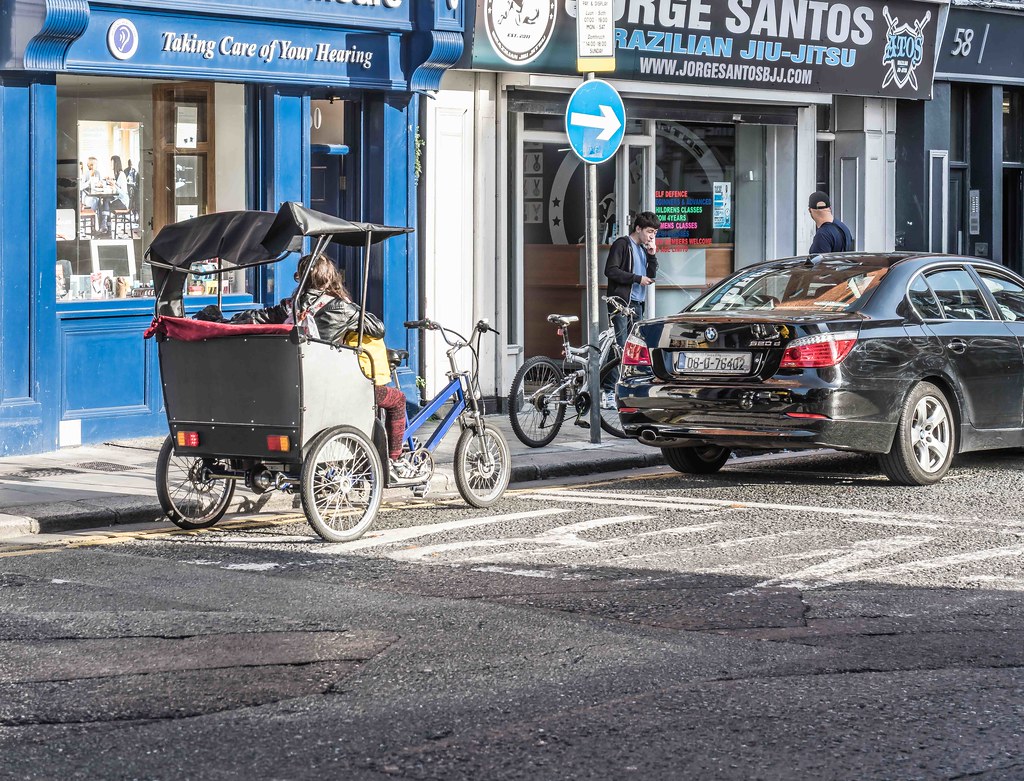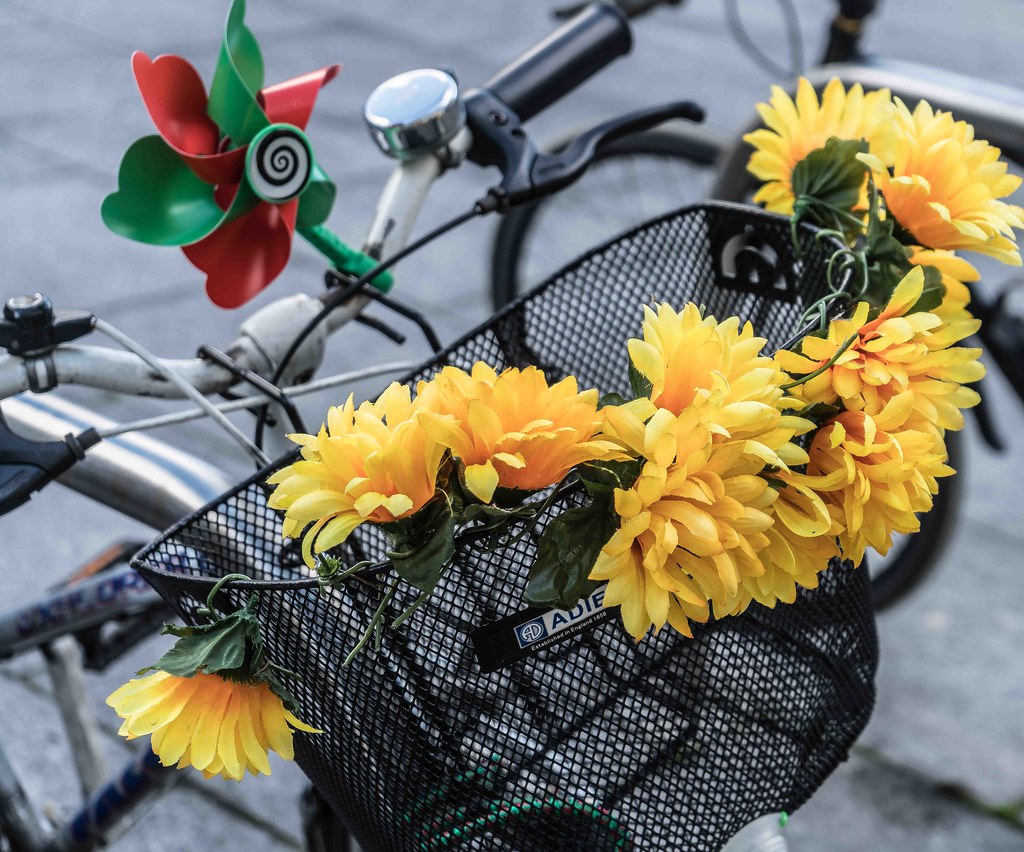DUBLIN TRANSPORT - BICYCLE
A bicycle, often called a bike or cycle, is a human-powered, pedal-driven, single-track vehicle, having two wheels attached to a frame, one behind the other. A bicycle rider is called a cyclist, or bicyclist.
Bicycles were introduced in the 19th century in Europe and as of 2003, more than 1 billion have been produced worldwide, twice as many as the number of automobiles that have been produced. They are the principal means of transportation in many regions. They also provide a popular form of recreation, and have been adapted for use as children's toys, general fitness, military and police applications, courier services, and bicycle racing.
The basic shape and configuration of a typical upright or "safety bicycle", has changed little since the first chain-driven model was developed around 1885. But many details have been improved, especially since the advent of modern materials and computer-aided design. These have allowed for a proliferation of specialised designs for many types of cycling.
The bicycle's invention has had an enormous effect on society, both in terms of culture and of advancing modern industrial methods. Several components that eventually played a key role in the development of the automobile were initially invented for use in the bicycle, including ball bearings, pneumatic tires, chain-driven sprockets, and tension-spoked wheels.
Around the turn of the 20th century, bicycles reduced crowding in inner-city tenements by allowing workers to commute from more spacious dwellings in the suburbs. They also reduced dependence on horses. Bicycles allowed people to travel for leisure into the country, since bicycles were three times as energy efficient as walking and three to four times as fast.
In built up cities around the world, urban planning uses cycling infrastructure like bikeways to reduce traffic congestion and air pollution.A number of cities around the world have implemented schemes known as bicycle sharing systems or community bicycle programs. The first of these was the White Bicycle plan in Amsterdam in 1965. It was followed by yellow bicycles in La Rochelle and green bicycles in Cambridge. These initiatives complement public transport systems and offer an alternative to motorised traffic to help reduce congestion and pollution. In Europe, especially in the Netherlands and parts of Germany and Denmark, bicycle commuting is common. In Copenhagen, a cyclists' organisation runs a Cycling Embassy that promotes biking for commuting and sightseeing. The United Kingdom has a tax break scheme (IR 176) that allows employees to buy a new bicycle tax free to use for commuting.
In the Netherlands all train stations offer free bicycle parking, or a more secure parking place for a small fee, with the larger stations also offering bicycle repair shops. Cycling is so popular that the parking capacity may be exceeded, while in some places such as Delft the capacity is usually exceeded. In Trondheim in Norway, the Trampe bicycle lift has been developed to encourage cyclists by giving assistance on a steep hill. Buses in many cities have bicycle carriers mounted on the front.
Bicycles were introduced in the 19th century in Europe and as of 2003, more than 1 billion have been produced worldwide, twice as many as the number of automobiles that have been produced. They are the principal means of transportation in many regions. They also provide a popular form of recreation, and have been adapted for use as children's toys, general fitness, military and police applications, courier services, and bicycle racing.
The basic shape and configuration of a typical upright or "safety bicycle", has changed little since the first chain-driven model was developed around 1885. But many details have been improved, especially since the advent of modern materials and computer-aided design. These have allowed for a proliferation of specialised designs for many types of cycling.
The bicycle's invention has had an enormous effect on society, both in terms of culture and of advancing modern industrial methods. Several components that eventually played a key role in the development of the automobile were initially invented for use in the bicycle, including ball bearings, pneumatic tires, chain-driven sprockets, and tension-spoked wheels.
Around the turn of the 20th century, bicycles reduced crowding in inner-city tenements by allowing workers to commute from more spacious dwellings in the suburbs. They also reduced dependence on horses. Bicycles allowed people to travel for leisure into the country, since bicycles were three times as energy efficient as walking and three to four times as fast.
In built up cities around the world, urban planning uses cycling infrastructure like bikeways to reduce traffic congestion and air pollution.A number of cities around the world have implemented schemes known as bicycle sharing systems or community bicycle programs. The first of these was the White Bicycle plan in Amsterdam in 1965. It was followed by yellow bicycles in La Rochelle and green bicycles in Cambridge. These initiatives complement public transport systems and offer an alternative to motorised traffic to help reduce congestion and pollution. In Europe, especially in the Netherlands and parts of Germany and Denmark, bicycle commuting is common. In Copenhagen, a cyclists' organisation runs a Cycling Embassy that promotes biking for commuting and sightseeing. The United Kingdom has a tax break scheme (IR 176) that allows employees to buy a new bicycle tax free to use for commuting.
In the Netherlands all train stations offer free bicycle parking, or a more secure parking place for a small fee, with the larger stations also offering bicycle repair shops. Cycling is so popular that the parking capacity may be exceeded, while in some places such as Delft the capacity is usually exceeded. In Trondheim in Norway, the Trampe bicycle lift has been developed to encourage cyclists by giving assistance on a steep hill. Buses in many cities have bicycle carriers mounted on the front.
SORRY FOR THE DELAY
You will find links to buy products from Amazon, Google and other partners. If you click on these links, you’ll find that the URL includes a small extra piece of text which identifies that the click came from my websites. This text is an affiliate code, and it means that I get a small percentage of the money you spend if you choose to buy that product, or, in some cases, other products from the site soon after. These affiliate links help pay the costs of producing my websites and ensure that the content is free to you.
COPYRIGHT INFORMATION BELOW APPLIES ONLY TO PHOTOGRAPHS

This work by William Murphy aka Infomatique is licensed under a Creative Commons Attribution-NonCommercial-ShareAlike 4.0 International License.
Permissions beyond the scope of this license may be available at https://excellentstreetimages.com/in-the-year-twentytwenty/copyright/.


